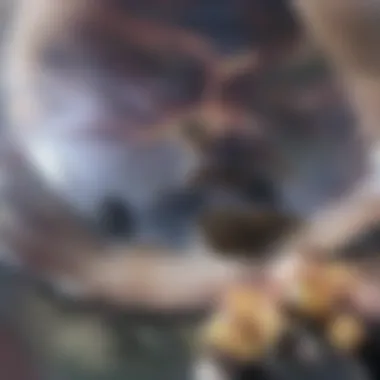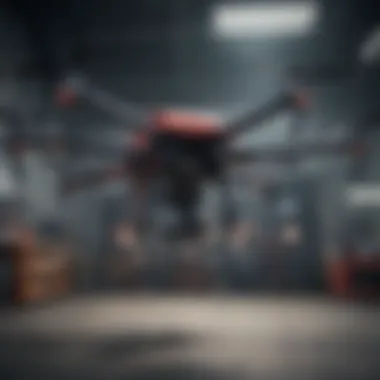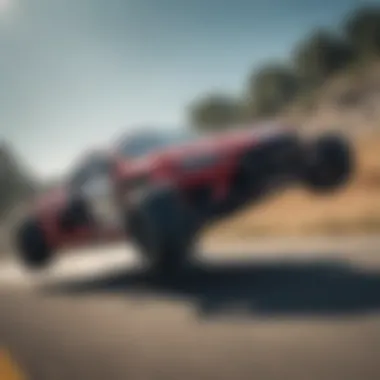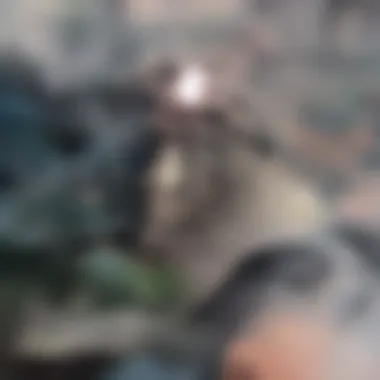Exploring Rotor Riot FPV: A Guide to Drone Culture


Intro
In recent years, the realm of drone technology has evolved significantly, carving out a distinct space for First-Person View (FPV) flying. Rotor Riot stands as a pivotal player in this landscape, shaping the community and fostering innovation. This article explores various dimensions of Rotor Riot FPV, emphasizing its role in promoting both competitive and recreational drone activities. The guide examines the development of Rotor Riot, its technological advancements, and the community atmosphere it nurtures. Through this exploration, readers will gain insights into the motivations behind FPV flying and the impact of Rotor Riot on this vibrant culture.
Community Dynamics
Evolution of FPV Drones
First-Person View drones have changed how enthusiasts engage with flying technology. Initially, FPV provided a way for users to experience flight through a camera perspective. As technology advanced, so did the FPV systems, evolving into high-performance machines. Rotor Riot has been influential in this progression, emphasizing quality and accessibility.
The Role of Rotor Riot
Rotor Riot serves multiple functions within the FPV community. It promotes educational resources and competitions. By producing engaging video content and tutorials, Rotor Riot enables more individuals to enter the FPV world. This accessibility encourages diverse participation, enhancing the competitive spirit. Hence, it creates a supportive environment where beginners can learn alongside seasoned pilots.
Technological Advancements
Equipment and Accessories
Rotor Riot is synonymous with cutting-edge drone technology. They offer a range of products designed for both new and experienced users. Notable offerings include high-performance drones, customizable frames, and superior quality cameras. The focus on performance ensures that enthusiasts can push their limits, whether flying for fun or racing competitively.
Integration with Software
Advancements in software have also played a significant role in enhancing FPV flying experiences. Rotor Riot collaborates with developers to offer apps that facilitate drone setup and flight planning. This technological synergy allows users to optimize their setups efficiently, leading to improved flight performance.
"The integration of technology in FPV has transformed the way enthusiasts interact with their drones, making the hobby more accessible."
Cultural Impact
Competitive Spirit
The competitive FPV scene has grown considerably, with Rotor Riot being a driving force behind many events and competitions. They host races and freestyle contests that attract pilots from various backgrounds. These competitions foster a sense of community, encouraging participants to share insights and techniques.
Recreational Flying
Besides competitive aspects, Rotor Riot promotes recreational flying, allowing enthusiasts to enjoy the thrill without competition. Local meetups and events organized by Rotor Riot foster camaraderie among participants. This blend of competition and leisure reinforces the cohesion of the FPV community.
End
The impact of Rotor Riot on the FPV drone community is undeniable. By offering advanced technology, promoting competitive events, and supporting recreational flying, they have carved out a prominent position. Understanding these elements enhances appreciation for the complex ecosystem surrounding FPV drones and encourages further exploration.
Understanding FPV Drones
Understanding FPV drones requires an exploration into their unique characteristics and importance in today's technological landscape. First-Person View drones, commonly referred to as FPV drones, offer users an immersive experience in aerial navigation. Unlike traditional remote-controlled drones, FPV systems provide a real-time view of the flight through a camera mounted on the drone. This technology has transformed recreational flying, enabling enthusiasts to engage with their hobby in a more engaging and interactive manner.
The significance of FPV drones extends beyond mere recreation. They are a vital component in numerous applications, from racing to aerial photography. Understanding the components and workings of these drones is fundamental for both users and manufacturers. Knowledge about FPV systems leads to improved safety, better performance, and overall satisfaction in the drone flying experience.
Definition and Overview
FPV drones allow pilots to see from the drone's perspective, creating a unique flying experience. The pilot controls the drone using a pair of goggles or a screen that displays the live feed from the drone's camera. This technology adds a significant layer of realism to drone flying, making it feel as if the operator is actually in the cockpit.
The landscape of FPV drones is broad, encompassing various use cases and audiences. From casual hobbyists to competitive racers, the applicability of FPV systems is vast. Understanding this diversity is essential for anyone looking to engage with the FPV community.
Key Components of FPV Systems
Cameras


Cameras are a critical component of FPV systems. They capture live video which is transmitted to the pilot. A key characteristic of FPV cameras is their lightweight design, which ensures minimal impact on drone performance. Many pilots prefer high-definition cameras for a clearer view. However, the resolution can significantly affect latency and transmission range, presenting a trade-off that pilots must consider. Notably, many cameras feature adjustable lenses for varying fields of view, enhancing versatility in different flying environments.
Transmitters
Transmitters play a vital role in transmitting the camera feed back to the pilot's goggles. They are designed for minimal size and weight but must also provide reliable signal strength. The key characteristic of a good transmitter is its ability to offer a clear signal over long distances while minimizing lag. Pilots often choose transmitters with adjustable frequencies to avoid interference during competitive events. This feature allows flexibility and assurance of signal stability, which is crucial for high-stakes flying.
Receivers
The receiver's function in the FPV system is equally important. Receivers pick up the transmitted signal from the drones and convert it into a format that can be used by goggles or screens. One notable aspect is their sensitivity, which can directly impact the clarity of the video feed. High-sensitivity receivers are essential for flying in areas with signal disruption. They allow better reception even at longer ranges, enhancing the pilot's experience, especially in complex environments.
Goggles
Goggles are where the magic happens for FPV pilots. They provide the immersive experience of flying by presenting a first-person view. A key characteristic of FPV goggles is comfort, as pilots often wear them for extended periods. Many models also come with customizable settings to adjust display brightness and contrast, improving visibility under different lighting conditions.
Some advanced goggles include features such as head tracking, enabling a more nuanced control by turning the pilot's head. However, they can be pricier, leading pilots to weigh their benefits against their budget constraints.
Typical Uses and Applications
Racing
FPV racing has gained immense popularity due to its exhilarating nature and competitive spirit. It enables pilots to navigate through complex courses at high speeds, relying heavily on their skills and the responsiveness of their drones. The key characteristic is the environment, which often includes obstacles that require precision flying. Racing draws in a large community of enthusiasts, providing a platform for competitions that stimulate innovation in drone technology.
Recreational Flying
Recreational flying remains the most widespread use of FPV drones. It allows users to explore the skies from an entirely new perspective, enhancing their engagement with nature. The appeal lies in the ease of use and accessibility. Casual users, including families and hobbyists, can enjoy flights without the pressure of competetion. However, factors such as local regulations and safety considerations impact where and how one can fly.
Aerial Photography
Aerial photography has leveraged FPV technology to capture stunning visuals from unique angles. High-quality cameras paired with advanced stabilization techniques make these drones ideal for filmmakers and photographers. A notable feature is their ability to fly at low altitudes while maintaining stable imagery, which is advantageous for capturing landscape shots. Nonetheless, the learning curve for effectively using FPV drones for photography can be steep, as it requires control and familiarity with the drone's capabilities.
Rotor Riot: An Prolusion
Rotor Riot is a significant entity in the realm of FPV drones, impacting the landscape of aerial technology and community engagement. This section will clarify the origins, key players, and foundational ethos of Rotor Riot. Understanding these elements is crucial for comprehending its role in enhancing both competitive and recreational aspects of FPV drone flying. Rotor Riot serves not only as a brand but as a catalyst for collaboration and innovation within the FPV community.
Origins and Founding
Rotor Riot was established in 2015, born out of a passion for first-person view flying and drone racing. The founders, a group of avid FPV enthusiasts, sought to create a platform that would elevate the sport and foster better connections among pilots. This initiative stemmed from observing a lack of resources and community support as drone technology rapidly grew. The founding members recognized an opportunity to unite like-minded individuals and provide access to information, products, and experiences tailored to the FPV flying community.
Key Figures Behind Rotor Riot
The impact of Rotor Riot can be attributed to several key figures within the FPV realm. Among them, Kwad Guy and Leigh Zermeno stand out. Their contributions extend beyond mere product promotion. They engage with the community through demonstrations, educational content, and livestreams that showcase the technical nuances of FPV flying. These individuals embody the spirit of Rotor Riot, emphasizing accessibility and inclusivity, which are core to the brand's identity. Their active participation in events, social media, and online communities has solidified Rotor Riot's reputation as a leading force in the FPV world.
Mission and Vision
Rotor Riot's mission is fundamentally tied to promoting a vibrant and engaged FPV community. The vision emphasizes innovation and education, recognizing the need for pilots to access quality resources and support. By offering a variety of products, engaging content, and hosting events, Rotor Riot aims to enhance the overall experience of drone flying. The brand nurtures talents and encourages new enthusiasts, believing that the future of FPV depends on fostering curiosity and collaboration among pilots. This focus not only propels individual growth but also strengthens the entire FPV ecosystem.
The Rotor Riot Impact
The impact of Rotor Riot extends far beyond the products they offer. It resonates throughout the FPV drone community, shaping social dynamics and skill development. As the FPV scene grows, Rotor Riot provides critical infrastructure that fosters both participation and competition. This section will delve into how Rotor Riot contributes to community building, supports pilots and enthusiasts, and promotes the thrilling world of FPV racing.
Community Building
Rotor Riot has established itself as a central hub for FPV enthusiasts. This community is not just about flying drones; it's about connection and shared experiences. Through events, forums, and social media, Rotor Riot encourages collaboration among pilots of all skill levels. The community creates a rich tapestry of knowledge and support, where experienced flyers mentor newcomers. This fosters a sense of belonging that keeps the hobby engaging and vibrant.
Support for Pilots and Enthusiasts


Sponsorship Programs
Rotor Riot's sponsorship programs provide vital support to aspiring pilots. These programs allow talented individuals access to resources they may otherwise lack. The key characteristic of these sponsorships is their focus on elevating emerging talent. Enthusiasts gain funding and equipment, which can significantly enhance their training and competition readiness. However, the distribution of these resources can sometimes favor those already more established, creating possible challenges for newcomers seeking support.
Training and Workshops
Training and workshops hosted by Rotor Riot further emphasize skill development. These events offer hands-on experience that is crucial for learning. Participants receive professional guidance, which simplifies complex concepts in drone flying. The unique feature of these workshops is their community-oriented approach. They encourage interaction among participants, creating a learning environment that extends beyond the sessions. Although they may require registration fees, the benefits often outweigh the costs, providing exceptional value for attendees.
Promotion of FPV Racing
Events and Competitions
Rotor Riot plays a significant role in organizing events and competitions that elevate FPV racing. These events attract both casual flyers and seasoned pilots, fostering healthy competition. The unique feature of competitions is their ability to showcase a wide range of skill sets and styles. They encourage pilots to push their boundaries and innovate, contributing to the overall growth of the sport. However, the competitive nature can sometimes lead to high-pressure situations, challenging participants' mental resilience.
League Structures
The establishment of league structures within Rotor Riot enhances the competitive landscape. These leagues provide a framework where pilots can compete regularly, honing their skills over time. A key characteristic of these league structures is their inclusion of various formats, catering to different interests within the FPV community. They offer a clear path for progression, motivating participants to continue improving. Nevertheless, the structure may favor those with more resources, which could limit wider participation.
"The community and competitive aspects of Rotor Riot have transformed how enthusiasts engage with FPV flying."
Through its endeavors in community building, support for pilots, and promotion of racing, Rotor Riot significantly impacts the FPV ecosystem. This influence not only aids in fostering a vibrant culture but also ensures that the excitement of drone flying continues to evolve.
Technical Overview of Rotor Riot Products
Understanding the technical aspects of Rotor Riot products is crucial in evaluating their position in the FPV drone market. This section delves into the unique offerings and functionalities of these products, allowing enthusiasts to make informed decisions. By analyzing features, performance, and user experiences, we provide a comprehensive perspective essential for both newcomers and experienced FPV pilots.
Drone Models Offered
Overview of Features
Rotor Riot presents a diverse range of drone models, each designed with specific functionality in mind. The most notable characteristic is the integration of high-performance components, which ensures a responsive flying experience. Their models often include enhanced motors, advanced flight controllers, and a variety of customizable settings that allow users to tailor their flights to personal preferences.
One unique feature of Rotor Riot drones is the community-based design approach, where suggestions from professional pilots directly influence product development. This creates a product line that not only performs well but also resonates with the needs of users. While these drones are generally praised for their capabilities, potential users should be aware of the learning curve associated with advanced features, especially for those new to FPV flying.
Target Audience
The target audience for Rotor Riot products spans a wide spectrum. From casual drone hobbyists to serious racers, the product lineup caters to various skill levels and interests. The appeal lies in the aforementioned advanced features, which attract skilled pilots aiming for competitive performance. One cannot overlook the community aspect; enthusiasts often share modifications and techniques, fostering a rich environment for learning and growth.
A unique feature of this target group is the emphasis on hands-on experience, where pilots are encouraged to participate in events and competitions to enhance their skills. However, this focus might intimidate beginner users who may find the community-driven culture overwhelming at first.
Performance Evaluations
Speed
In terms of speed, Rotor Riot drones are engineered for high performance. Many models feature proprietary motors that deliver rapid acceleration, allowing pilots to achieve impressive speeds during races. This capability is not only thrilling but also critical for competitive environments. The quick response time can give pilots a significant edge over competitors, making these drones popular among race participants.
Nevertheless, potential users should evaluate their own skill levels, as managing high-speed flights requires substantial practice and experience.
Stability
Stability is another cornerstone of Rotor Riot drones. Advances in flight control technology ensure that these models maintain a steady flight path even under challenging conditions. The consistent performance is a strong benefit for both recreational users and competitive pilots, as it provides the confidence to execute complex maneuvers.
However, it is essential to note that stability can be affected by external factors like wind conditions. Thus, pilots should always assess weather conditions before flight to ensure optimal stability.
Durability


Durability plays a significant role in the overall effectiveness of Rotor Riot products. Many models are constructed using robust materials that withstand crashes and harsh usage. For any FPV pilot, endurance is crucial since accidents are an inevitable part of flying.
The unique design often incorporates reinforced frames and protective components, reducing the impact of routine wear and tear. Users can enjoy flying without constant worry about damaging their equipment. However, while the durability features are commendable, they can also add weight, which may compromise performance.
User Feedback and Reviews
User feedback provides invaluable insights into the Rotor Riot product experience. Many pilots highlight the exceptional quality and performance of the drones. Reviews frequently emphasize the standout features like response time and stability.
"Rotor Riot drones are really engineered for action. You can feel the difference in control when flying at speed."
However, some reviews reflect on the learning curve associated with the more advanced functionalities. This suggests that continuous education and community engagement are key for new pilots looking to harness the full potential of their drones.
The Future of Rotor Riot FPV
The future of Rotor Riot FPV is an essential aspect of this article as it encapsulates the ongoing evolution within the drone industry and its implications for enthusiasts. Developing technologies and changing trends shape how pilots interact with their devices. Rotor Riot, a pioneer in the FPV community, stands at the forefront of these advancements. By focusing on emerging technologies, predicted trends, and sustainable practices, this section outlines what lies ahead for Rotor Riot and its advocacy for FPV innovation.
Emerging Technologies
AI Integration
AI integration is becoming more prevalent in FPV drones. It brings about enhanced automation and intelligent features that improve user experience. One key characteristic is real-time data analysis. With this capability, drones can assess their environment quickly and adapt accordingly. This makes flying more intuitive for users.
A notable feature of AI in this context is obstacle avoidance. Using sensors and cameras, drones equipped with AI can navigate complex environments without crashing. For many users, this level of sophistication can make FPV flying more accessible and enjoyable. However, reliance on AI features might limit manual flying skills development, a point of concern among some traditionalists in the community.
Enhanced Augmented Reality
Enhanced augmented reality (AR) technology introduces another layer to the FPV experience. AR allows pilots to overlay information onto the real-world video feed. A key characteristic of this technology is its ability to provide navigational data, flight statistics, and even instructional overlays in real time. This not only enriches the pilot's experience but also aids in better decision-making while flying.
One unique feature of AR in FPV applications is its visualization of flight paths on screen. This feature can help pilots in planning their flights more effectively. Additionally, it can boost safety by providing critical information while managing complex maneuvers. Nevertheless, integrating AR can introduce distractions, making it essential for users to find a balance in utilizing the technology while maintaining focus on flying.
Predicted Trends in FPV Racing
The landscape of FPV racing is continuously shifting. A notable predicted trend is the increase in professional racing leagues. As the popularity of FPV grows, more organizations may establish official events. This could lead to greater sponsorship opportunities and elevate FPV racing into a more recognized sport.
Additionally, advancements in drone technology will likely influence racing. A demand for faster and more reliable drones pushes manufacturers to innovate. Expect to see lighter materials, improved battery technology, and enhanced communication systems that will redefine what is possible in competitive scenarios.
Sustainable Practices in FPV Production
As environmental awareness increases, sustainable practices in FPV production become critical. Rotor Riot and others in the industry may prioritize eco-friendly materials and processes. This could involve using recyclable components and reducing waste in manufacturing.
Moreover, the push for sustainability might lead to collaborations between drone manufacturers and environmental organizations. These alliances could drive the adoption of responsible practices within the FPV community. Emphasizing sustainability not only addresses global concerns but can also resonate with consumers who value environmental stewardship.
In summary, the future of Rotor Riot FPV is marked by innovation, evolving fan dynamics, and a growing focus on sustainability. These changes will shape how drones are designed, marketed, and used, ultimately enriching the FPV experience for users.
The End: The Role of Rotor Riot in the FPV Ecosystem
Rotor Riot plays a pivotal role in the First-Person View (FPV) drone ecosystem. This organization has not only added to the technological advancements in drone design but has also fostered a strong community among enthusiasts, pilots, and newcomers alike. Understanding its significance involves looking at how it bridges the gap between innovative technology and community engagement, ultimately shaping the future of FPV flying.
Summary of Key Points
- Community Engagement: Rotor Riot excels in creating spaces for pilots to connect. Events such as competitions and workshops help to build relationships and share knowledge among participants.
- Advancement in Technology: Their contributions to FPV technology, including drone designs and accessories, demonstrate their commitment to improving user experience.
- Educational Initiatives: Through training programs and sponsorships, Rotor Riot empowers aspiring pilots, making FPV flying accessible to a broader audience.
- Cultural Impact: By promoting FPV racing and recreational flying, Rotor Riot helps cultivate a culture that embraces creativity, competition, and collaboration.
"The essence of Rotor Riot lies in its ability to unite the community while pushing the boundaries of what is possible with FPV drones."
Final Thoughts on FPV's Evolution
The evolution of FPV is remarkable, with Rotor Riot at the forefront forging pathways for both competition and leisure. As technology continues to advance, the influence of Rotor Riot will likely grow stronger. The integration of emerging tech, such as artificial intelligence and augmented reality, is on the horizon, promising to reshape the FPV experience.
Moreover, the focus on sustainability within FPV production reminds us that the future must consider environmental factors. Rotor Riot is well-positioned to adapt to these changes, ensuring its relevance in the fast-evolving landscape of FPV drones. Understanding this evolution offers valuable insights for anyone interested in the field.
Rotor Riot exemplifies how community-driven innovation can lead to a richer, more inclusive hobby. The organization not only empowers newer pilots but also inspires seasoned enthusiasts to explore new heights in their FPV journeys.







